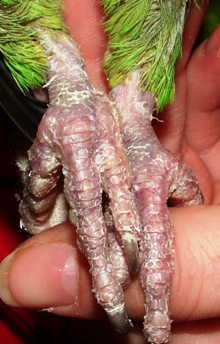For the public
Toys & Behavioral Enrichment for Pet Birds
Parrots and other birds are intelligent, curious and naturally active in the wild. The typical wild bird spends most of its day searching for food and being alert for predators. When it is not looking for food, it may be searching for a mate or helping take care of a nest, protecting its home from rivals, socializing with other birds, or preening its feathers, among other activities. As pets, birds no longer have to search for food, worry about predators, defend their home from rivals, or do many of the other things necessary to survive in the wild. Without these things to do, some parrots and other birds begin to engage in abnormal behaviors such as feather-plucking and chewing at their skin, pacing around their cages, back-flipping, eating their own stool, prolonged abnormal screaming, etc.
Eye Swelling in Birds
Screaming Behavior in Pet Birds
Screaming is the second most common problem noted by parrot owners. Normal parrot vocalizations include alarm calls and contact calls. Alarm calls occur when the parrot is feeling as if it is in danger or distress. Contact calls are vocalizations used to identify where other members of the bird’s flock are at any given time. Both of these types of calls are normal. It is also normal for some parrot species to call and scream for 15 to 20 minutes several times a day, especially in the morning, and may be a way that wild parrots tell other parrots from another flock to stay away. When a parrot begins to repeatedly vocalize for prolonged periods of time this is considered to be abnormal and may indicate stress or boredom. Studies on parrot behavior have shown that one cause of problematic screaming may be a lack of physical interaction between social partners (i.e., other birds or its human companions).
Providing the Right Light for Pet Birds
- Parrots require at least 10 hours of sleep time each night.
- Parrots need full spectrum UVB light daily if strictly indoors.
- Ideally parrots benefit from time outside in their cage.
- Parrots awaken easily from movement within the house.
Need for Light
PDS & Bornavirus
PDS, which is short for Proventricular Dilatation Syndrome, causes regurgitation, weight loss, and death in macaws and other parrots. This condition has recently been linked with a poorly understood virus known as bornavirus. Bornavirus has been linked with feather-plucking, toe-tapping, and other conditions in parrots.
Getting a New Bird
You need to plan ahead before you bring a bird into your home. Part of that planning should include a same-day wellness visit to a reputable veterinarian since there is no way to be sure a bird is completely healthy just by looking at it. After a physical examination, the veterinarian may discuss screening your new bird with laboratory tests. Simple tests can be done at the hospital, such as looking at droppings and oral secretions for abnormal bacteria using a Gram stain or checking the droppings for parasites. However, additional tests are often needed particular for birds that have been around many other birds. The importance of this additional testing cannot be ignored -- one study using protein electrophoresis, a kind of blood test, revealed that 30% of seemingly healthy birds had undetected infectious or inflammatory disease. Specific tests for psittacosis (also known as parrot fever or chlamydophilosis), Pacheco's virus, and psittacine beak and feather disease may be important especially if you have other birds at home. If the Gram stain suggests abnormal bacteria are present then microbiological cultures and sensitivities should be performed so that the right antibiotic can be chosed to treat the infection. Your new bird can have its sex determined by saliva, blood, or feather samples to confirm that you got what you paid for or to learn what you got. When you are budgeting for a new bird, make sure you remember to include money for a thorough health check!
Feather Plucking & Self-Mutilation
Behavioral disorders are a frequent issue identified in companion parrots and one study revealed that 36% of owners felt their bird had a behavioral problem. Feather destructive behavior, more commonly known as feather-picking or feather-plucking, was the most common behavior problem seen by veterinarians and the fourth most common behavioral problem identified by owners. This issue can result from both medical and behavioral causes.
Feather Loss and Circovirus Infection
Psittacine Circovirus (Psittacine Circoviral Disease or PCD) is a viral infection that is spread easily through feathers and feces. It affects parrots and other psittacine birds and causes the loss of feathers, usually on the chest or thighs. In some birds, such as Eclectus, king parrots, and lorikeets, the early signs may be a change in color, with affected feathers showing streaks of white, yellow, or black. Cockatoos and parrots often show loss of the powder down first since powder down is replaced often; it may take a few molts to see changes in coverlets and other feathers. With time, the feather loss involves the wings and the rest of the body. Early in the infection, feathers may grow in to replace the missing ones. These regrown feathers are abnormally-shaped and easily break at their bases. As the infection progresses, new feathers do not grow and old ones are not replaced. Infected birds may show excessive abnormal growth of the beak and toenails. The beak and nails curl in unusual shapes. The beak and nails may flake, crack, and develop soft areas that are weak and may break. Yeast and other infections may develop in cracks of the beak and nails. Beaks can become so severely affected that the bird can no longer feed on its own.
Biting Behavior in Birds
Biting is one of the most common behavior problems noted in pet parrots.




